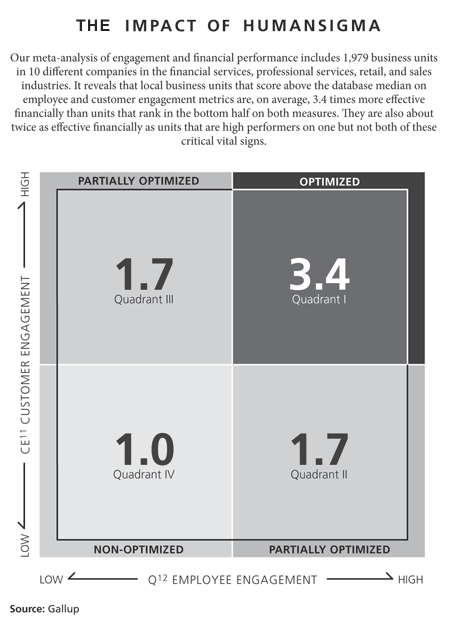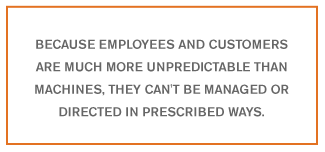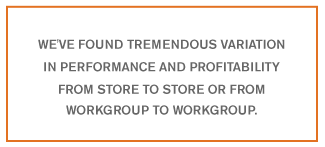In every company, there are workgroups that outperform the others, sometimes enormously. These groups are more productive, profitable, customer-focused, safer, and more likely to withstand the temptation to go elsewhere. ���۴�ýspent years researching how to replicate their success -- and found that employee engagement is the key to high performance.
In every company, there are customers who outspend the others, sometimes enormously. They visit more often, resist competitive overtures, promote your brand to others, and forgive the occasional service hiccup. ���۴�ýspent years researching how to replicate those customer relationships -- and found that customer engagement is the key to high profitability.
But then the researchers uncovered something puzzling. The data showed that when workgroups with engaged employees served engaged customers, the end result was something more than the sum of its parts. The equation of "engaged employees + engaged customers" produced results far exceeding what the researchers expected. So they dug deeper.
Using meta-analysis to analyze 1,979 business units in 10 different companies, they found that workgroups that score above the median on employee engagement and below the median on customer engagement are 1.7 times more financially effective than units that score below the median on both measures. Results were similar for workgroups that achieved the opposite results: above the median on customer engagement, below the median on employee engagement. But workgroups that scored above the median on both customer and employee engagement were, on average, 3.4 times more financially effective than the units ranking in the bottom half on both measures. They called the management approach developed to measure and manage the human systems in business "HumanSigma." (See graphic "The Impact of HumanSigma.")
 |
It took a few more years to figure out how and why HumanSigma works and how to integrate the science into businesses. In their book Human Sigma: Managing the Employee-Customer Encounter, ���۴�ýresearchers John H. Fleming, Ph.D. and Jim Asplund explain HumanSigma and how companies can use it to get the most from their human systems.
In part one of this interview, the authors provide explicit insights for GMJ readers: what companies do to undermine HumanSigma; why people, not products, are the fulcrum of profitability; and why it's tempting to replace workers with machines -- and why you really, really shouldn't.
GMJ: How much of your thinking on HumanSigma is owed to Six Sigma?
Dr. Fleming: My answer to that is "some." Six Sigma offers some good conceptual ideas that help an organization improve itself by improving its processes. But remember that Six Sigma was developed in a manufacturing context, and the role people played in its equation was relatively small.
Once businesses had wrung all the improvements they could from improving their processes, they tried to apply Six Sigma to their human systems. And they failed, because people are hard to "fix." HumanSigma was developed as a response to the lack of effectiveness of Six Sigma methodology to increase productivity from people.
GMJ: Why are people so hard to fix?
 |
Asplund: There are a couple of good reasons. If you buy a tractor or a furnace, you know what you're going to pay for it, how it'll depreciate, what the maintenance costs are likely to be, and roughly when it will quit working. If it pulls a load or melts steel at a given rate today, it'll perform the same or very close to it tomorrow.
But people don't work that way. They're unpredictable, both in ways that you might appreciate and ways that you don't. So because people -- employees and customers -- are much more unpredictable than machines, they can't be managed or directed in prescribed ways.
GMJ: You open the book by discussing "Terminator Management" as a failed way to cope with human unpredictability. Tell me what that is and why you think it's flawed.
Fleming: In the movies, the Terminator is programmed to accomplish a task, and he doesn't know how to do anything other than accomplish that task. He has no discretion, no learning capacity -- he just goes. What we call the "Terminator School of Management" deals with the difficulty of managing people by ignoring or squashing their humanity. We use it as a metaphor of how organizations squeeze human initiative and responsiveness from the service delivery system by scripting the range of behaviors that an employee is allowed to execute.
It's essentially a conventional way of thinking, the idea that "It would be great to get rid of all my employees; I'd be much happier if they were machines." But it's not effective in driving real organic growth and real change.
GMJ: How do you create real organic growth and change?
Fleming: When a company scripts employee behaviors, telling people exactly how to do the job rather than having them focus on the outcomes they should achieve if the job is done well, it creates automatons. It might reduce variability in how the job is done, but it also increases variability in the desired outcome. The result is service with no soul: bland, soulless, and undifferentiated.
The paradox here is that to achieve the desired outcome -- emotional engagement -- companies may actually need to increase the variability in the steps to create it. Executing bland, undifferentiated service will not create engaged customers, and it won't get you organic growth. Customers who buy more and shop more often create organic growth. Engaging them emotionally will create organic growth. Machines may execute tasks flawlessly, but they can't engage customers. And customers want more than transactions; they want relationships. Only people can build those.
GMJ: In your book, you said the employee-customer encounter is the new factory floor. What did you mean by that?
Fleming: If you contrast manufacturing environments with service economy environments, you need a new definition of value creation for a service economy. The definition that we landed on was that value is created when an employee and a customer come together and they interact.
That's different from manufacturing, where you create value by making a product that is ready to be sold. Creating value in a manufacturing context is fairly straightforward -- if you have a lot of broken products, you have problems; if you have no broken products, no poor-quality products, then your business can flourish.
In a service economy business, so much more is riding on the interactions that your employees have with your customers. You need a new set of tools to evaluate how well you're doing.
GMJ: Does HumanSigma apply to employees who don't interact directly with customers?
Asplund: Yes. Think of the guy on the loading dock; he may never talk to a customer. But if he drops a TV before he loads it on the truck or if he takes an extra three days to get it to the store, it affects customers regardless of whether he ever talks to them.
GMJ: You say in the book that companies should manage the employee and customer experience in tandem. But doesn't that require massive reorganization, all new integration of departments, different foci for leadership? How should you do it and why do you say it's worth doing?
Fleming: I'm not sure that bringing those two things together is all that radical a proposition. It doesn't happen very much today, but that doesn't mean it can't. HumanSigma has to be conceptualized and managed holistically. For example, one of the recommendations we make in the book is that if your company is not going to reorganize and create new human systems, the very least it can do is create a steering committee. That group should be responsible for HumanSigma initiatives and include representatives from all areas that are affected by them. Just getting your marketing and operations and human resources departments talking to one another and working together could create fundamental change.
GMJ: You used the word "soul" a lot in Human Sigma, and you emphasize the essential humanity of business. Why is humanity important in business? And how can companies control the emotional reactions of employees and customers?
 |
Asplund: A company can't control people's emotional reactions -- but let me step back for a moment. The reason a company must understand the essential humanity of its customers and employees is because they are people first and customers and employees second. They're living, breathing, real people. Before a business can manage them effectively, it must understand how customers and employees think and how they react; it must understand their psychology and their emotional infrastructure.
Another thing to consider is that most companies treat people as rational in their decision making when they really are not. The vast majority of human decisions aren't made strictly through rational thought processes; they're made in many other ways, including intuitively. Habits and simple rules that developed in cultures thousands of years ago can predispose us to behave in certain ways. More of our reasoning is based on emotions than you would suppose.
Fleming: The employee-customer encounter is fundamentally emotional, and it must be measured and managed locally. We've found tremendous variation in performance and profitability from store to store or from workgroup to workgroup. But you won't see the variation at the business unit level, much less at the individual level, if you examine the operation too broadly. And we've found that telling employees to behave in exactly the same way with customers can actually increase variation.
GMJ: How? Doesn't outlining the procedural steps, essentially telling irrational humans exactly what to do, lead to better outcomes and higher profits?
Fleming: No. If you standardize everything, then everything becomes standard.
GMJ: Well, that's good, right? Standard is better than variation, isn't it?
Fleming: No. It just creates mediocrity. There's a paradox here that is important to recognize. What we're suggesting is that companies that have concentrated on creating consistency of execution have failed to create consistency in the outcomes that execution is intended to produce. Most are trying to control the process through which employees are delivering service by mandating the steps.
We flip that by telling companies to clearly define the outcomes, which include establishing emotional connections with customers. Companies should allow employees a much greater range of flexibility -- within clearly defined boundaries -- to achieve those outcomes and to establish and maintain connections with customers.
 |
GMJ: Because customers aren't engaged by processes but by people.
Fleming: Exactly.
GMJ: But this seems very risky. Most companies are loath to give frontline staff that much responsibility.
Asplund: It's actually less risky than you might think, because your employees are doing it their way anyway, and they're not channeling their efforts effectively. They're people, and they're behaving like people. Trying to control their behavior just won't work.
Fleming: Instead, what you should do is understand their behavior and what makes them tick. Then try to use that understanding to manage them more effectively. Ultimately, that may mean you should exert less control over the execution to achieve more control over the outcome.
GMJ: But ceding control chips away at the power structure, and that's going to be hard for some executives to swallow.
Fleming: I think we're talking more about the control structure than the power structure. Terminator Management is really about a need for control. This approach sacrifices real service quality in favor of the illusion of control.
What we're advocating is for executives to let go of some of that control. You know, it's like the old adage: It's hard to reach for the future when you're holding on to the past. Sometimes you have to open your hands and let go of old ideas in order to grasp new ones.
-- Interviewed by Jennifer Robison
In part two of this interview, Fleming and Asplund discuss how HumanSigma works on a macroeconomic scale. They talk about the financial vital signs that HumanSigma provides -- and, unlike other indicators, provides in real time. They also explain the concept of optimization -- how extremely high HumanSigma scores affect business outcomes -- and how to get there.
